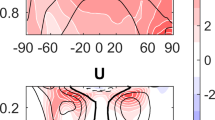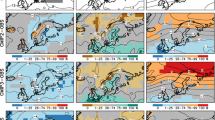Abstract
The sensitivities of two climate-model versions—INMCM4 which participated in the Coupled Model Intercomparison Project, Phase 5 (CMIP5), and a new INMCM5 version with increased vertical and horizontal resolutions in its atmospheric block—to the quadrupled concentration of CO2 are studied. When the CO2 concentration is quadrupled, the equilibrium increase in surface temperature amounts to about 4.2 K for INMCM4, which is lower than that for other models that participated in the CMIP5. When the CO2 concentration increases, the cloud radiative forcing in the model decreases; in this case, one portion of this decrease occurs during the first year after the concentration of CO2 is quadrupled and the other portion almost linearly depends on the value of global warming. The results of additional numerical experiments with the model show that a rapid decrease in cloud-radiative forcing results from variations in stratification in the atmospheric surface boundary layer and associated increased cloudiness. The portion of a linear decrease in cloud-radiative forcing with increased temperature is associated with an increase in the water content of model clouds at higher temperatures. The elimination of these two mechanisms allows one to increase the model sensitivity to the quadrupled concentration of CO2 up to 5.2 K.
Similar content being viewed by others
References
G. A. Meehl, T. F. Stocker, W. D. Collins, P. Friedlingstain, A. Gaye, J. M. Gregory, A. Kitoh, R. Knutti, J. M. Murphy, A. Noda, S. Raper, I. Watterson, A. Weaver, Z. Zhao, et al., “Global climate projections,” in Climate Change 2007. The Physical Science Basis (Cambridge Univ. Press, Cambridge, 2007), pp. 748–845.
S. Bony, R. Colman, V. Kattsov, R. P. Allan, C. S. Bretherton, J. L. Dufresne, A. Hall, S. Hallegatte, M. M. Holland, W. Ingram, D. A. Randall, B. J. Soden, G. Tselioudis, and M. Webb, “How well do we understand and evaluate climate change feedback processes?,” J. Clim. 19(15), 3445–3482 (2006).
E. M. Volodin, “Relation between temperature sensitivity to doubled carbon dioxide and the distribution of clouds in current climate models,” Izv., Atmos. Ocean. Phys. 44(3), 288–299 (2008).
T. Andrews, J. M. Gregory, M. Webb, and K. Taylor, “Forcing, feedbacks and climate sensitivity in CMIP5 coupled atmosphere-ocean climate models,” Geophys. Res. Lett. 39(9) (2012). doi: 10.1029/2012GL051607
E. M. Volodin, N. A. Dianskii, and A. V. Gusev, “Simulating present-day climate with the INMCM4.0 coupled model of the atmospheric and oceanic general circulations,” Izv., Atmos. Ocean. Phys. 46(4), 414–431 (2010).
M. Tolstykh, R. Ibraev, E. Volodin, K. Ushakov, V. Kalmykov, A. Shlyaeva, V. Mizyak, and R. Khabeev, Global Models of the Atmosphere and World Ocean. Algorithms and Supercomputing Technologies (Moscow Univ., Moscow, 2013) [in Russian].
J. M. Gregory, W. J. Ingram, M. A. Palmer, G. S. Jones, P. A. Stott, R. B. Thore, J. A. Lowe, T. C. Johns, and K. D. Williams, “A new method for diagnosing radiative forcing and climate sensitivity,” Geophys. Res. Lett. 31(3) (2004). doi: 10.1029/2003GL018747
R. J. Stouffer and S. Manabe, “Response of a coupled ocean-atmosphere model to increasing atmosphere carbon dioxide: sensitivity to the rate of increase,” J. Clim. 12(8), 2224–2237 (1999).
G. Danabasoglu and P. R. Gent, “Equilibrium climate sensitivity: Is it accurate to use slab ocean model?,” J. Clim. 22(9), 2494–2499 (2009).
V. A. Alekseev, E. M. Volodin, V. Ya. Galin, V. P. Dymnikov, and V. N. Lykosov, Preprint no. 2086-B98 INM RAS (Institute of Numerical Mathematics, Russian Academy of Sciences, Moscow, 1998).
M. Watanabe, S. Emori, M. Satoh, and H. Miura, “A PDF-based hybrid prognostic cloud scheme for general circulation models,” Clim. Dyn. 33(6), 795–816 (2009).
I. P. Mazin, “On the climatology and physical structure of clouds,” Izv. Akad. Nauk, Fiz. Atmos. Okeana 30(3), 338–344 (1994).
E. M. Volodin and N. A. Dianskii, “Simulation of climate changes in the 20th–22nd centuries with a coupled atmosphere-ocean general circulation model,” Izv., Atmos. Ocean. Phys. 42(3), 267–281 (2006).
Author information
Authors and Affiliations
Corresponding author
Additional information
Original Russian Text © E.M. Volodin, 2014, published in Izvestiya AN. Fizika Atmosfery i Okeana, 2014, Vol. 50, No. 4, pp. 399–405.
Rights and permissions
About this article
Cite this article
Volodin, E.M. Possible reasons for low climate-model sensitivity to increased carbon dioxide concentrations. Izv. Atmos. Ocean. Phys. 50, 350–355 (2014). https://doi.org/10.1134/S0001433814040239
Received:
Accepted:
Published:
Issue Date:
DOI: https://doi.org/10.1134/S0001433814040239




